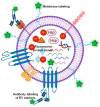Nanoparticle Tracking Analysis: An Effective Tool to Characterize Extracellular Vesicles
- PMID: 39407601
- PMCID: PMC11477862
- DOI: 10.3390/molecules29194672
Nanoparticle Tracking Analysis: An Effective Tool to Characterize Extracellular Vesicles
Abstract
Extracellular vesicles (EVs) are membrane-enclosed particles that have attracted much attention for their potential in disease diagnosis and therapy. However, the clinical translation is limited by the dosing consistency due to their heterogeneity. Among various characterization techniques, nanoparticle tracking analysis (NTA) offers distinct benefits for EV characterization. In this review, we will discuss the NTA technique with a focus on factors affecting the results; then, we will review the two modes of the NTA techniques along with suitable applications in specific areas of EV studies. EVs are typically characterized by their size, size distribution, concentration, protein markers, and RNA cargos. The light-scattering mode of NTA offers accurate size, size distribution, and concentration information in solution, which is useful for comparing EV isolation methods, storage conditions, and EV secretion conditions. In contrast, fluorescent mode of NTA allows differentiating EV subgroups based on specific markers. The success of fluorescence NTA heavily relies on fluorescent tags (e.g., types of dyes and labeling methods). When EVs are labeled with disease-specific markers, fluorescence NTA offers an effective tool for disease detection in biological fluids, such as saliva, blood, and serum. Finally, we will discuss the limitations and future directions of the NTA technique in EV characterization.
Keywords: exosomes; extracellular vesicles; fluorescent labeling; nanoparticle-tracking analysis.
Conflict of interest statement
The authors declare no conflicts of interest.
Figures



Similar articles
-
Differential fluorescence nanoparticle tracking analysis for enumeration of the extracellular vesicle content in mixed particulate solutions.Methods. 2020 May 1;177:67-73. doi: 10.1016/j.ymeth.2020.02.006. Epub 2020 Feb 17. Methods. 2020. PMID: 32081745
-
Characterization of Extracellular Vesicles from Bronchoalveolar Lavage Fluid and Plasma of Patients with Lung Lesions Using Fluorescence Nanoparticle Tracking Analysis.Cells. 2021 Dec 9;10(12):3473. doi: 10.3390/cells10123473. Cells. 2021. PMID: 34943982 Free PMC article.
-
Enumeration of extracellular vesicles by a new improved flow cytometric method is comparable to fluorescence mode nanoparticle tracking analysis.Nanomedicine. 2016 May;12(4):977-986. doi: 10.1016/j.nano.2015.12.370. Epub 2016 Jan 6. Nanomedicine. 2016. PMID: 26767510
-
Preparation and characterization of extracellular vesicles.Am J Reprod Immunol. 2021 Feb;85(2):e13367. doi: 10.1111/aji.13367. Epub 2020 Nov 16. Am J Reprod Immunol. 2021. PMID: 33118232 Review.
-
Emerging strategies for labeling and tracking of extracellular vesicles.J Control Release. 2020 Dec 10;328:141-159. doi: 10.1016/j.jconrel.2020.08.056. Epub 2020 Aug 31. J Control Release. 2020. PMID: 32882270 Review.
Cited by
-
Protocol for the isolation and characterization of murine hematopoietic stem and progenitor cell-derived extracellular vesicles.STAR Protoc. 2025 Jun 20;6(2):103778. doi: 10.1016/j.xpro.2025.103778. Epub 2025 Apr 17. STAR Protoc. 2025. PMID: 40252223 Free PMC article.
-
Isolation of Plasma Extracellular Vesicles for High-Depth Analysis of Proteomic Biomarkers in Metastatic Castration-Resistant Prostate Cancer Patients.Cancers (Basel). 2024 Dec 21;16(24):4261. doi: 10.3390/cancers16244261. Cancers (Basel). 2024. PMID: 39766159 Free PMC article.
-
Evaluating the In Situ Effects of Whole Protein Coronas on the Biosensing of Antibody-Immobilized Nanoparticles Using Two-Color Fluorescence Nanoparticle Tracking Analysis.Nanomaterials (Basel). 2025 Jan 30;15(3):220. doi: 10.3390/nano15030220. Nanomaterials (Basel). 2025. PMID: 39940196 Free PMC article.
-
Exosomal peptides and proteins in wound healing and skin regeneration.Naunyn Schmiedebergs Arch Pharmacol. 2025 Jul 8. doi: 10.1007/s00210-025-04426-y. Online ahead of print. Naunyn Schmiedebergs Arch Pharmacol. 2025. PMID: 40627201 Review.
-
Exosomes in Precision Oncology and Beyond: From Bench to Bedside in Diagnostics and Therapeutics.Cancers (Basel). 2025 Mar 10;17(6):940. doi: 10.3390/cancers17060940. Cancers (Basel). 2025. PMID: 40149276 Free PMC article. Review.
References
Publication types
MeSH terms
Substances
LinkOut - more resources
Full Text Sources

